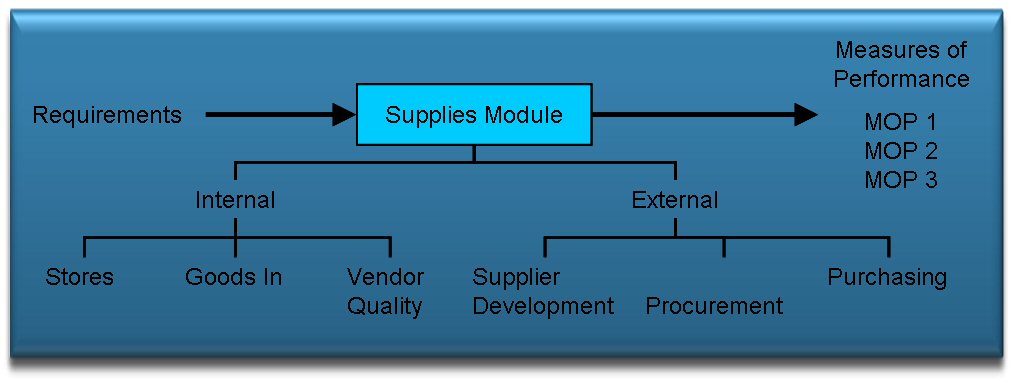5.06 - Supplier Integration
Overview
Supplier integration is a key element in achieving competitive performance, because a high proportion of a businesses income from sales is likely to be spent with suppliers of materials and services. Supplier integration provides opportunities for:-
- Material Cost Savings
- Reduced inventory levels
- Higher quality service from approved suppliers
- Reduced expenditure on inspection, administration and paper-work (no-value added activities)
Good supplies practice is dependent upon the formation of a supplies module with visible ownership which is responsible for co-ordinating the activities shown and delivering quality products Just-in-Time to the manufacturing process.

Stores
- Minimise Incoming Materials holding - must be monitored
- Minimise stocks (say 1% of sales - ship to shop-floor strategy)
- Only strategic items held
- Packaging - suitable for use by production (e.g. ABC materials)
- ABC categorisation for control simplicity
Goods Inwards
- Receive parts on a Just-In-Time basis.
- Frequent deliveries of a few hours production
- Use of Kanban to signal for more supplies
- Majority of items pass directly into factory
- ABC categorisation for control
Vendor Quality
- Minimum inspection (e.g. by ABC category, FMEA RPN etc)
- Vendor conformance reports
- Provide feedback on total performance
- Vendors responsible for providing corrective actions
- Require evidence of continuous improvement
Purchasing
- Integration with supplier for placing of commercial contracts (e.g. negotiation of contracts on call-off basis)
- Reduce number of suppliers
- Discuss future requirements on master production schedule with suppliers
- Introduce blanket orders based on levelled schedules for integrated runners, repeaters and strangers.
- Target the reducing of cost of all bought-out materials, services and contracts by NVA reduction
- Ensure quality and delivery standards are clear and visible
Procurement
- Movement of material from supplier to manufacturing module, based on contracts negotiated by purchasing (i.e. responsible for the process of calling-off if a call-off contract has been negotiated by purchasing for example)
- Responsibility of manufacturing product unit
- Material movement based upon Kanban, levelled schedule or period flow control
Supplier Development
- Understands strengths and deficiencies of suppliers
- Establish common rules as a basis for discussion related to planning, control, attitude, handling, tooling, plant, quality and response
- Employ well trained, skilled supplier development engineers - external manufacturing systems engineers
It is important to establish performance measures (see guide 5.21)
for the supplies modules to encourage continuous improvement and to provide week-to-week control, including a focus on individual buyer performance.